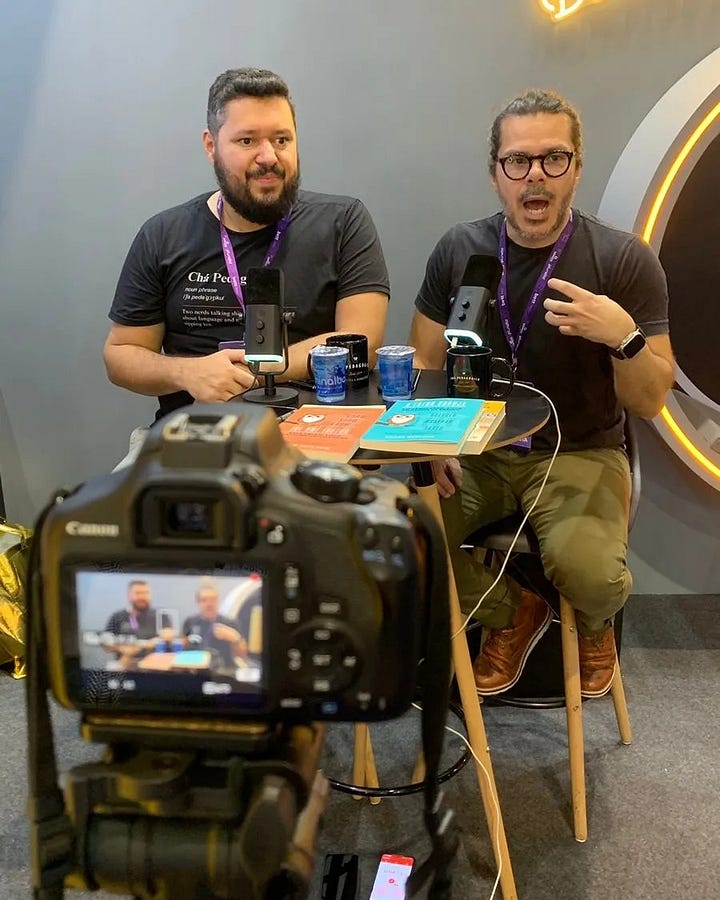Technomania, Technophobia, or Technosmart: Bett and the EdTech Conundrum
In an age of overstimulation, rising anxiety, and digital overload, is it time for schools to rediscover the power of silence, reflection, and intentional tech use?
A few years ago, my buddy Rodolfo Mattiello and I were prepping for our monthly podcast Chá Pedagógico. We ended up talking about music, as we often do, especially if it involves the Four Lads of Liverpool, and somehow got Simon & Garfunkel’s The Sound of Silence stuck in our heads. That episode turned into a reflection on quiet time and contemplation in our classrooms.
How ironic.
Fast forward to 2024 and 2025, and guess what? Rudy and I are still talking about silence and the desperate need for it in learning contexts. Just a few days ago, we had the same conversation again after recording a live episode at the Bett Conference, the largest EdTech event in Latin America. It was déjà vu: one year after our first live episode of Chá Pedagógico at Bett, we found ourselves surrounded by flashy booths and “cutting-edge” solutions promising to maximize, enhance, or guarantee learning outcomes.


But here’s the thing: amidst all the hype, which was the word of the week, we kept coming back to the same question. Are schools - and we can add parents and family here - mistaking stimulation for innovation and learning?
Technomania
With around 40,000 attendees, many of whom never miss an edition, Bett São Paulo this year felt like a gold rush. Everyone seemed to be searching for the "next big thing" for their schools. And there’s definitely a lot to choose from. The usual suspects are always there:
gamified assessment platforms
all sorts of Learning Management Systems (LMS)
virtual and augmented reality
coding and robotics (there was even a robot dog that reminded me of a Black Mirror episode)
adaptive learning systems
classroom management dashboards with real-time analytics
student wellbeing tracking apps
digital portfolios and e-badging systems
parent-teacher communication apps
immersive language learning platforms
smart boards and IoT classroom devices
But of course the new solutions have something to do with AI:
AI-powered personalized learning tools
chatbots for automated feedback and tutoring
“AI tutors” that promise to replace homework help
AI-driven essay correction
It all feels incredibly progressive, I’ll give you that. But this mania often disregards the real issues and offers shiny distractions that may actually hinder learning. Many schools are hooked on the idea of modernization at any cost. They chase after the latest platforms and gadgets as symbols of innovation, often skipping fundamental reflections and steps about the actual learning gain of students, how teachers are supported, and what might be the unintended consequences.
There’s a growing risk of what could be called “solutionism”, which is the belief that every educational challenge has a quick tech fix. However, education is deeply human, and sometimes, the most meaningful progress doesn't come from adding more features, but from slowing down and limiting access to these devices.
Has the EdTech “revolution” delivered?
In 2020 and 2021, teachers all over the world were only able to keep working because of some type of digital and online technology. Without at least a videoconferencing tool and a digital device, there could have been no classes in most settings. Many experts shared their thoughts about how this would boost the EdTech industry and propel us 5 or maybe 10 years ahead. All the excitement sometimes blurred what was going on in many educational settings: anxiety and despair.
I witnessed firsthand the struggle of teachers trying to adapt overnight to these technologies that had been part of education for at least 10 years but hadn't yet made their way into most classrooms. These teachers have always relied on face-to-face classes, and many of them simply couldn't adapt fast enough and ended up getting fired or burning out - sometimes both.
Five years after the global pandemic started, after hours of mentoring teachers, talking to school managers and families, watching schools buy fancy equipment and advertise they have completely revolutionized the "learning experience", I can't help but think how it all sounds too good to be true. There was no revolution in education apparently. As a matter of fact, this promise is old. Actually, the headline of The Heritage Foundation in 2010 read:
How Online Learning is Revolutionizing K-12 Education and Benefiting Students
According to Dan Lips, senior policy analyst in education at the time, online learning expanded the reach of education, helped flexibilize and customize learning, and made schools more productive. The report mentions meta-analyses conducted by the US Department of Education showing that online learning was overall as good as or better than traditional face-to-face learning. They did mention that for very young children, it seemed to be less effective.
However, 10 years after this so-called revolution, what evidence was there to support the claims mentioned above? Well, the 2019 J-PAL’s Education Technology Evidence Review, discussed in the MIT Technology Review, actually suggests that classroom technology was holding students back. One of the issues with this tech is:
Motivation. If Kevin had been asked to combine 8 and 3 by a teacher rather than an iPad, there's a greater chance he would have been interested in trying to do it. "It's different when you're learning from a person and you have a relationship with that person," cognitive psychologist Daniel Willingham has said. "That makes you care a little bit more about what they think, and it makes you a little bit more willing to put forth effort."
A total of 129 studies were included, as summarized in the MIT News, suggesting that the impact of technology on student learning is not quite as positive:
Online courses are developing a growing presence in education, but the limited experimental evidence suggest that online-only courses lower student academic achievement compared to in-person courses. In four of six studies that directly compared the impact of taking a course online versus in-person only, student performance was lower in the online courses. However, students performed similarly in courses with both in-person and online components compared to traditional face-to-face classes
OK, you’re probably thinking: “But this is about online classes, André. What about all the other tech “solutions” mentioned on your list above?”
Well, before we get into that, maybe we should think about the other side of this story.
Technophobia
On the other side of this continuum, a different kind of anxiety is growing, and I’m more concerned with this one. It’s less about missing out on the latest tech, and more about what we’re losing in the process. Parents, educators, and even students themselves are starting to express concerns over the impact of excessive screen time, digital addiction, and the mental health toll of being online and isolated most of the time.
I have already discussed on this blog the mechanisms and consequences of screen addiction.
Screen Addiction: How Digital Devices are Affecting our Brains
I have bad news. I’m addicted to screens. And you might be too. Maybe you don’t know it, and perhaps you’re even denying my accusation, but try to answer the following before you attempt to defend yourself:
Many educators and families have asked me for help during my workshops in several schools in Brazil (and even abroad). They are clueless about how to get students to detach from their devices, even when it’s time to rest, reflect, or simply be present with others. It’s no wonder Chá Pedagógico’s most-watched episode was about celebrating Brazil’s recent mobile phone ban in classrooms.
And then there’s the mental health crisis. Several studies now link high screen time, especially among adolescents, to increased rates of anxiety and depression. If you want to understand the seriousness of this issue, just take your pick:
The Anxious Generation: How the Great Rewiring of Childhood Is Causing an Epidemic of Mental Illness (Jonathan Haidt)
Screen Damage: The Dangers of Digital Media for Children (Michel Desmurget)
Dopamine Nation: Finding Balance in the Age of Indulgence (Anna Lembke)
In fact, why don’t you start with Jared Horvath’s guest post below:
What then? Should schools stop using digital tech? I suppose this cautionary stance isn’t a call to ban technology, but actually a plea to use it with more intention based on the research we have access to.
Technosmart
Back to Chá Pedagógico, maybe what we need instead of all this tech noise is just a little patience… and silence. Silence isn’t just the absence of noise, it’s an essential condition for learning. As a matter of fact, Barbara Oakley discusses in her book with Terrence Sejnowski Learning How to Learn: How to Succeed in School Without Spending All Your Time Studying; A Guide for Kids and Teens:
Diffuse mode is when your mind is relaxed and free. You’re thinking about nothing in particular. You’re in diffuse mode when you’re daydreaming or doodling just for fun. If your teacher tells you to concentrate, you have probably slipped into diffuse mode. When you’re in diffuse mode, you’re gently using other parts of the brain that are mostly different from the parts you use when you are focusing. The diffuse mode helps you make imaginative connections between ideas. Creativity often seems to pop out of using the diffuse mode. It turns out that your brain has to go back and forth between focused and diffuse modes in order to learn effectively
Here are some questions you might want to ask before implementing some new digital tech tool in your classroom, while bearing in mind the need to create moments of quiet:
Does this tool enhance or replace thinking?
Remember the economics teacher in Ferris Bueller’s Day Off? He asked his class questions but never gave students enough time to respond. Instead, he quickly filled the silence with the answer. The best edtech shouldn’t steal time from thinking, it should give it more time. If a tool becomes a crutch that encourages cognitive passivity, it’s probably not helping learning. That means more “uncomfortable” silence in class. That’s right. Ask students a question and give them time to find an answer and refine it before grabbing the first search engine in front of them and saving themselves the - much-needed - mental effort.
Does it reduce or increase distractions?
Apps that grab students attention while they should be listening to your instructions are definitely a bad idea. Do I really need to point this out? Constant notifications, blinking badges, and 30-sec videos with no meaningful reflection are just helping students get addicted and find everything else boring. How many times have I heard from parents and teachers alike that kids and teens cannot focus anymore? We should look for tools that support sustained attention, not ones that fragment it further.
Does it connect or isolate?
This one is tricky because the promise of connection is embedded in lots of EdTech solutions (does “social” media ring a bell?"). But tech should not deepen the divide or encourage students to retreat further into individualized, algorithm-driven tunnels. Nor should it give them the feeling that everyone thinks like them. Instead, the right tools should help students collaborate, debate, share perspectives, and engage with diverse ideas, both online and face-to-face. Nothing makes me sadder than watching a bunch of kids glued to their phones at recess inside their schools when they could be talking to or playing with each other. The type of silence we witness here is the one that we don’t want.
Who benefits from the frenzy?
Feel free to call me a grumpy old-timer, even though I’m 39. But I do believe we have a lot to gain from just taking some time off and being quiet. On the other hand, those who benefit at EdTech conferences like Bett are the companies that produce and sell these so-called innovations. I know the world is evolving fast and we need to keep up. But we’ve never been so tech-driven in history. Yet, we’ve never worked this hard or felt this exhausted. Wasn’t technology meant to make our lives easier? Weren’t we supposed to have more free time on our hands? What everyone is witnessing is precisely the opposite.
EdTech tools should help enhance learning, not create more opportunities for multitasking. Teachers should worry about their students’ learning outcomes, not how to implement the latest tech tool, learn how to use it, and then do it all over again, usually unsupported, till the next big thing comes out. Learning more effectively does not have anything to do with delegating our thinking process to AI.
I don’t know about you, but I love sitting by the window of a bus or airplane and simply look outside. My mind wanders and I think about life. I love walking and just admire the beauty of nature. But I know that I too am addicted to these new tech tools.
When one of the largest educational conferences in the world proudly displays all the latest tech innovations, that tells us something about the times we’re living in. It’s a symptom and we can already see many of the consequences. At least, I also saw many booths with printed books, board games, furniture design, and tours to historical sites. Silence might not be flashy, but without it we can’t really learn effectively. And in a world obsessed with noise, that’s revolutionary in its own right.







